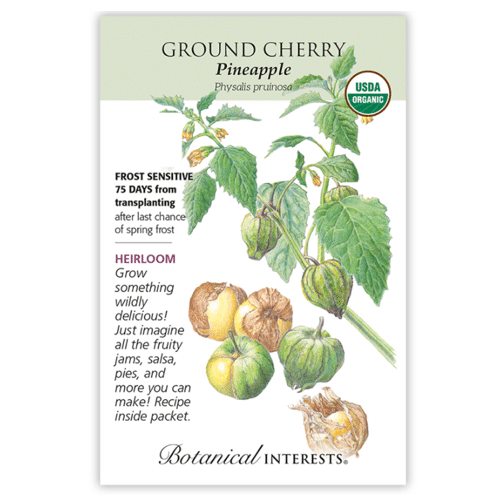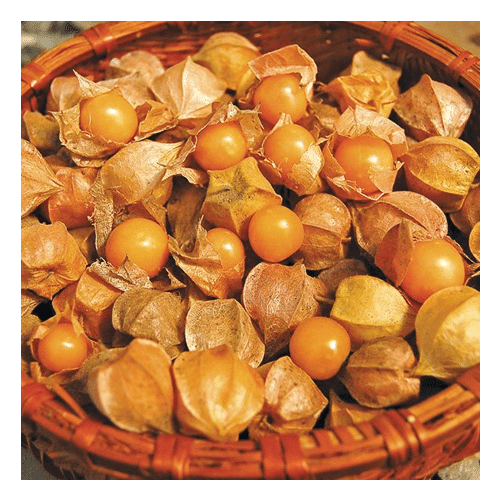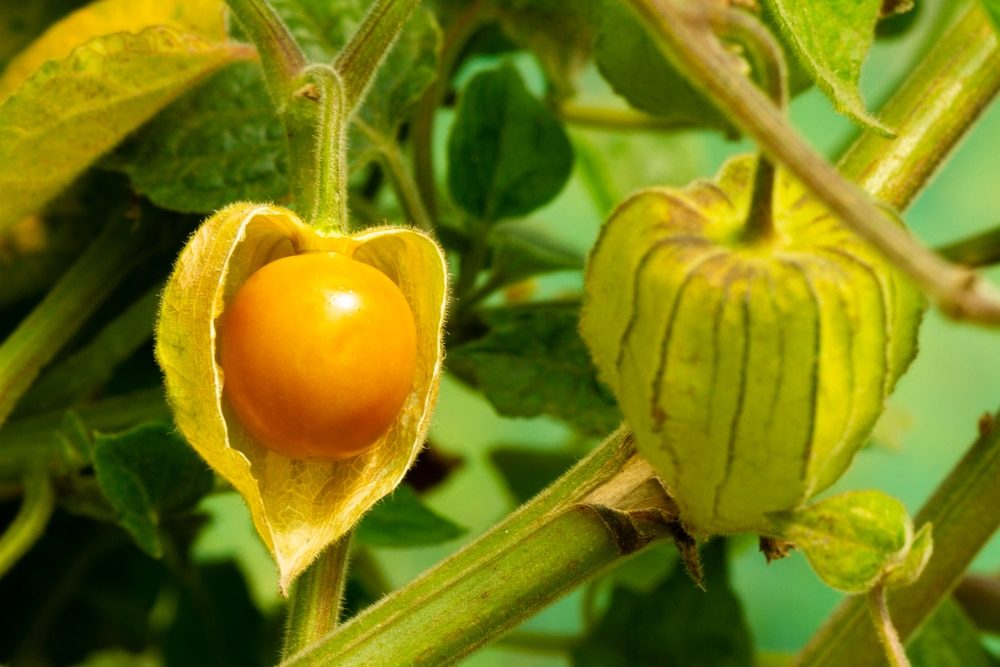
If you are looking to add a fast growing fruit to your garden, then look no further than the ground cherry. Ground cherry plants are vigorously growing nightshade plants which can produce up to 300 small golden fruit each year. Ground cherry fruit develop inside of a cone-like protective husk until they ripen and fall onto the ground (hence the name "ground" cherry). Like other nightshades, ground cherry plants are susceptible to frost and need plenty of warmth and sunshine. However, these plants can be easily grown in containers in growing zones prone to low temperatures and early frosts. This article will teach you everything you need to know to successfully grow ground cherries.
Snapshot: Successfully Growing Ground Cherries
When to Plant:
Start ground cherry seeds indoors 6-8 weeks before the average last frost date. Transplant young plants outdoors 2-4 weeks after last frost date.
How to Plant:
Plant seeds 1/4 deep in a seed starter pot and keep soil temperatures between 75°F-85°F
Germination:
Ground cherry seeds will germinate between 7-14 days after planting.
Watering:
Provide approximately 2 inches of water per week per ground cherry plant.
Sunlight:
Ground cherry plants need 6-8 hours of full sun each day.
Fertilizer:
Add a fish emulsion fertilizer to ground cherry plants when flowers begin to set to encourage fruit production.
Harvesting:
Harvest fruit when the protective husk turns brown and the inner fruit has a golden color. Ground cherries fall to the ground when near ripe.
Companion Plants
Best companion plants for ground cherries are attractors (marigolds) and repellers (parsley, basil, chives).
Getting Started: Growing Ground Cherries From Seed
Recommended Products for Growing Ground Cherries
Starting ground cherry plants from seeds is a simple process that is similar to the process of starting tomato plants. Ground cherry seeds germinate best in warm (between 75°F-85°F) loose soil with good drainage. It is highly recommended that ground cherry seeds get started indoors before transplanting outdoors. Warmth is essential for the successful germination of ground cherry seeds, so you may want to invest in a seedling heat mat to ensure that the soil temperature remains in the correct range. Here's what you need to do to start your ground cherry seeds:
Start Indoors:
- Start seeds indoors 6-8 weeks prior to the average last frost date for your growing zone.
Planting the Seeds:
- Fill a large seed starting pot high-quality seedling starter mix.
- Gently water the starter mix until it is moist.
- Place a group of 3 ground cherry seeds every 18”.
- Gently push the seeds ¼ inch into the soil and lightly cover with soil.
Daily Seedling Care:
- Place the seedlings in a sunny location or under an indoor grow light.
- Keep the soil moist. Mist the soil daily with a plant mister until seeds begin to sprout.
- Ground cherry seeds sprout within 10-14 days of planting.
After planting the seeds, your ground cherry plants will grow indoors for approximately 8-12 weeks before being hardened off and transplanted outdoors.
How to Transplant Ground Cherries
Ground cherries have vigorous root systems which are not prone to transplant shock. This makes transplanting young ground cherry plants a fairly easy task. The keys to successfully transplanting ground cherry plants are waiting for the right outdoor temperatures, acclimating your plants to the outdoors, and giving the plants the right amount of sunlight.
Wait Until It's Warm:
Ground cherries should be transplanted outdoors or into a container approximately 2-4 weeks after your zone’s last frost. Again, ground cherry plants thrive in warm soils so be sure that all danger of frost has passed before transplanting outdoors.
Harden Off:
After spending weeks indoors, ground cherry plants need to get slowly acclimated to their new outdoor environment (this process is called hardening off). To harden off your plants, let the plants spend a few days in a shady spot, a few days in a sunnier spot, and a few days in full sun.
Transplanting:
Like tomatoes, ground cherries have adventitious roots (tiny hairs on the stems that will form new roots when planted), so plant your transplants deeply to help your plants develop a strong root system. Amend the soil with compost or worm castings to encourage growth and plant the seedlings in an area that will receive at least 6-8 hours of full-sunlight each day. Cover the soil around your new plants with mulch to prevent weeds and to maintain soil moisture.
Ground Cherry Plant Spacing
Ground cherry plants grow relatively low to the ground and need plenty of room to spread. Each ground cherry plant can take up to 2-3 square feet per plant. Thus, each plant should be spaced about 3 ft apart.
How Long Does it Take For Ground Cherries to Grow?
Ground cherry seeds should germinate within 7-14 days of planting. After sprouting, ground cherry plants will grow indoors for another 6 weeks before needing to be hardened off and transplanted outdoors. Once transplanted outdoors, ground cherries take about 70 days to reach maturity.
Ground Cherry Plant Development
After transplanting, ground cherry plants develop into a short, somewhat sprawling bush that can extend out by 3 square feet. Soon, the plant will begin to produce small, pale yellow flowers which will eventually transform into golden fruit resembling a cherry tomato. Ground cherry fruit develop inside of a protective husk and typically remain inside of that husk until harvest. As the fruit ripens, the surrounding husk changes color from green to brown and becomes as thin as the paper which surrounds garlic bulbs. The fruit is ready for harvest when the fruit becomes a deep-golden yellow and easily falls off of the plant.
How to Care For Ground Cherry Plants
When to Water a Ground Cherry Plant?
Most ground cherry plants are happy with approximately 2 inches of water per week. The goal is to keep the soil moist, but not wet. Good drainage will help to prevent over watering.
When to Fertilize a Ground Cherry Plant?
If you transplanted your ground cherries into healthy soil, fertilization may not be necessary. Ground cherries are vigorous plants which can tolerate a wide range of soil conditions.
Signs that your plant may need fertilizer are yellowing leaves and slow growth. If you’d like to give your plant extra nutrients for greater fruit production, add fertilizer as your ground cherry plants begin to set flowers. The best fertilizer for ground cherries is a high-quality fish emulsion. This emulsion should be properly diluted according to the package instructions.
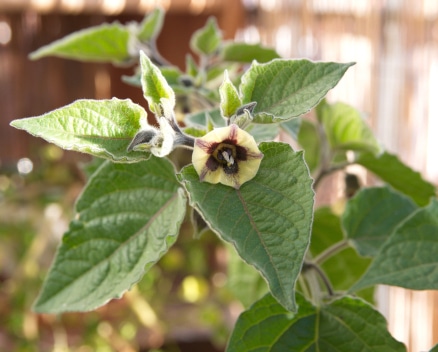
Growing Ground Cherries Outdoors
Looking to create an outdoor ground cherry garden? Ground cherries are a viable outdoor garden plant for most climates in zones 4 and above. They are relatively low maintenance, hardy against pests, and yield lots of fruit per plant. Just be sure to give your plants adequate space when planting outdoors as each plant can easily spread 2-3 sqft. Additionally, you'll want plenty of room to maneuver between plants to harvest your fruit.
Tips for Growing Ground Cherries Outdoors:
Start Indoors:
Even if you wish to grow your ground cherries outdoors, it is best to start your ground cherry seeds indoors. Ground cherries need warm, loose soil with good drainage to germinate and thrive as young plants. To ensure success, start seeds indoors on a seedling starter heat mat or grow light before hardening off and transplanting outside. Before planting outside, slowly acclimate your young ground cherry plants to the outside environment by giving them a few hours of exposure to the outdoors each day for about a week.
Transplant into Warm Soil:
Hold off transplanting outdoors until soil temperatures are at least 60°F or 2-4 weeks after your zone's average last frost.
Add Nutrients to Your Soil:
When transplanting, add some seaweed extract, compost, or worm castings into the hole and around the surrounding soil. This will help give your new plants a good start.
Keep the Ground Clean:
Ground cherries typically fall from the plant when ready to harvest. To make harvesting easier, keep the area underneath the plant weed-free and clear. This can be accomplished by heavily mulching with wood chips or straw or covering the ground with landscape fabric. You can also use a tomato cage to support the plant in an upright position and create more visible space underneath.
Use Row Covers:
The two biggest threats to your ground cherry plants outdoors are garden pests and frost. Floating row covers provide a lightweight barrier that is capable of both keeping small garden insects at bay and protecting against frost in temperatures as low as 28°F. Ground cherries will continue to produce fruit until experiencing frost. When frost threatens, cover your plants with floating row covers to extend your growing season.
Growing Ground Cherries in Containers
Ground cherries are a great fruit to grow in containers. Ground cherries tend to thrive so long as the container is large enough to support the plant's root system and provides enough drainage. The best part about growing ground cherries in pots is that a single plant can yield hundreds of small fruit--so you don't need many plants to have a meaningful harvest. It's a great plant to grow on a sunny deck, in a greenhouse, or in a raised garden bed.
Tips for Growing Ground Cherries in Containers:
Use a Large Planter:
Ground cherries grow in a bush-like manner and need plenty of room for their limbs and roots to spread. Transplant seedlings into large planter or grow bag that is at least 15 gallons in volume and 8 inches deep.
Place Container in Full Sunlight:
Ground cherries will grow well in a warm sunny location that gets 6-8 hours of direct sunlight such as a sun room or outdoor deck. If growing in a shaded location, use a grow light to supplement the needed sunlight hours.
Use Cages for Easier Harvest:
If you don't want your floors and decks covered in ground cherries, then it's best to take steps to control the growth of your plant. Tomato cages work well to reduce widespread sprawl and support vertical growth. You could also place your planter inside of a wide basket or tray that can catch any fallen fruit.
Beware of Indoor Pests:
Aphids and fruit gnats are common pests for indoor plants and ground cherries are not exception. Aphids can be treated with neem oil spray while fruit gnats are best treated with nematodes.
Provide Good Drainage and Fertilize:
Ground cherry plants need good drainage as their roots do not like sitting in wet soil. Be sure to use a well-draining soil and container that provides additional drainage. Amend the soil with compost or worm castings and be sure to add a fish emulsion fertilizer when the plant begins to flower.
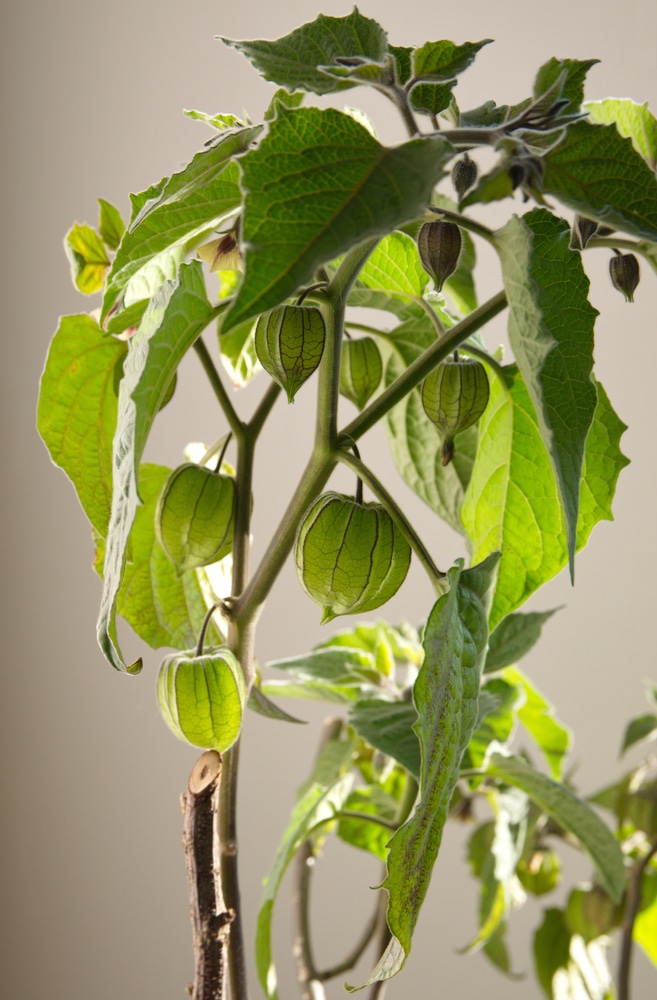
Best Ground Cherry Seeds
There are many varieties of plants hat get confused with true ground cherries. Tomatillos, cape gooseberries, and chinese lantern flowers may resemble ground cherries, but are technically not the same thing. True ground cherry varieties include Aunt Molly's, Pineapple, and Goldies. These are the most popular varieties which will produce a quintessential ground cherry fruit within 80 days of transplanting.
Aunt Molly’s Ground Cherry Seeds
Seed Savers Exchange
A polish variety of ground cherries that is also one of the most popular. Has a similar tart, tropical, fruity taste as do pineapple ground cherries but with less pineapple flavor. Matures in 70 days after transplanting.
Pineapple Ground Cherry Seeds
Botanical Interests
Pineapple ground cherries have a tart tropical flavor that is reminiscent of pineapples. They make excellent additions to salsa and jam recipes. Matures in 75 days after transplanting.
Goldie Ground Cherry Seeds
High Mowing Seeds
These ground cherries get their name from the fruit's deep golden color. These cherries are larger than the fruit produced by the pineapple and aunt molly varieties. Matures in 75 days after transplanting.
Ground Cherry Companion Plants
Similar to tomatoes and other nightshade plants, ground cherries benefit from companion plants such as basil, marigolds, and parsley. Herbs such as basil, chives, parsley, sage, and mint will work to repel common ground cherry pests. On the other hand, flowers such as marigolds help to attract beneficial pollinators. It is best not to plant ground cherries with corn, eggplants, tomatoes, peppers, potatoes, as well as other nightshades as they will compete for soil resources and attract similar pests. Additionally, nasturtiums can attract certain pests, so plant those far away from your ground cherries as a distraction.
Ground Cherry Pests & Diseases
Ground cherries are fairly hardy, weed-like plants which do not succumb easily to insect damage and plant diseases. A healthy ground cherry plant that is well watered and gets plenty of sunlight has minimal susceptibility to plant plights. However, in certain conditions and gardens, ground cherry plants can suffer from infestations of certain pests. Ground cherries share roughly the same pests as nightshades such as tomatoes and eggplants. Those pests include:
| Pest | Problem | Solution |
|---|---|---|
| Flea Beetles | Beetles chew small holes in plant leaves. | Plant basil, carrots, and parsley companion plants, use row covers after transplanting. |
| White Flies | Small insects suck nutrients from plants. | Trap flies with sticky paper, physically remove by spraying water, spray with soapy water. |
| Colorado Potato Beetle | Beetles chew small holes in plant leaves. | Hand picking, row covers, soapy water, and neem oil spray. |
| Hornworms | Extensive damage to leaves. | Physically remove worms, plant basil and marigolds as repellents. |
| Cut Worm | Worms that eat the base of young plants. | Physically remove worms and place coffee grounds + egg shells around plants. |
| Aphids | Small insects that suck nutrients from plants. | Plant mint, catnip, and basil companion plants. Try neem oil spray or soapy water on plant. |
| Birds, Squirrels, & Deer | Critters eat ripened fruit. | Row covers, fruit cages, and fencing. |
Harvesting & Storing Ground Cherries
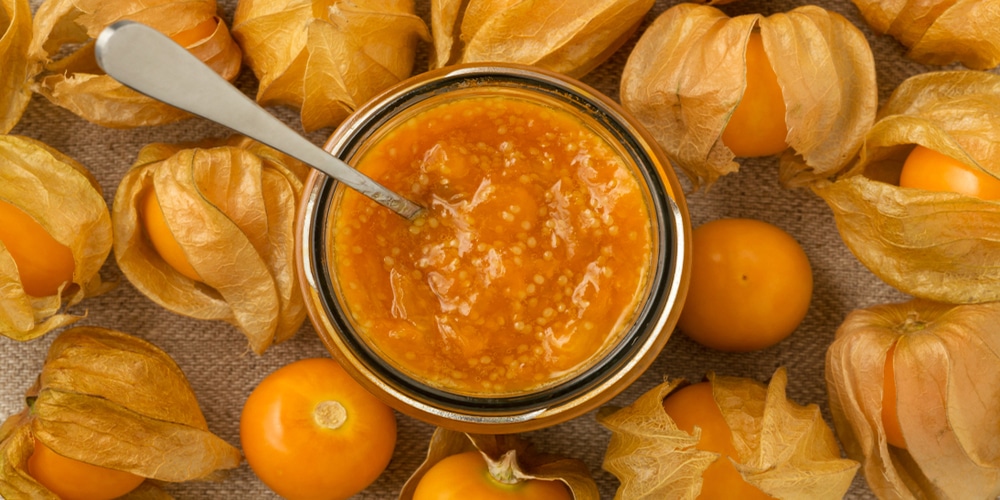
There is almost no guesswork required to determine if your ground cherries are ready for harvest. First, the green protective husk surrounding the fruit turns brown and takes on a paper-like texture. The fruit inside also changes color from green to a deep golden yellow. When the fruit is ready for harvest (or just a tad bit before fully ripening) it readily falls from the plant onto the ground.
To harvest, simply give the bush a light shake and pick up the fruit from the ground. To prevent fruit rot and to keep pests at bay, try to harvest the fallen fruit each day. Cherries that are not fully ripened yet can be left to ripen on the counter-top for about a week. Leave the protective husks on the fruit until ready to use.
Ground cherries can be eaten raw straight off of the plant or cooked into jams, pies, and other treats. Ground cherries can be stored in a cool (50°F), dark, well-ventilated location such as a root cellar for up to 3 months. They can also be frozen, dehydrated, or canned like jam.
Growing Ground Cherries Each Year
Ground cherries are considered annuals in zones 1-7 (typically dying off after experiencing frosty conditions) and perennials in zones 8 and above. However, you probably won't need to replant your ground cherries because these plants are known to drop many seeds and sprout volunteer plants each year.
Frequently Asked Questions About Ground Cherry Plants
Are Ground Cherries Dangerous for Dogs?
Similar to other nightshades, pets and livestock should avoid eating ground cherry leaves and green fruit. These parts of the plant can carry fatal levels of a toxic compound known as solanine.

